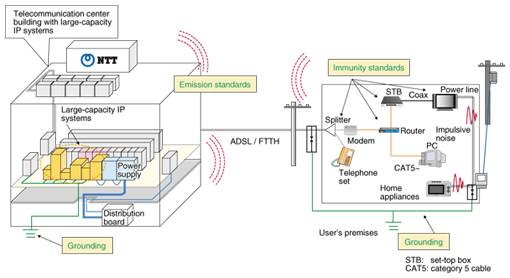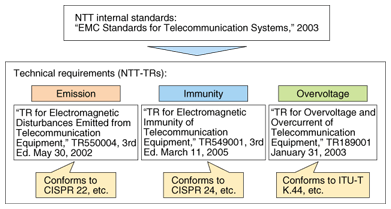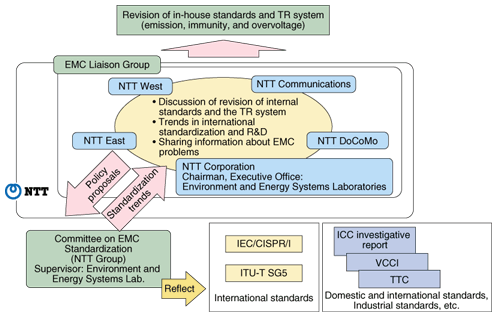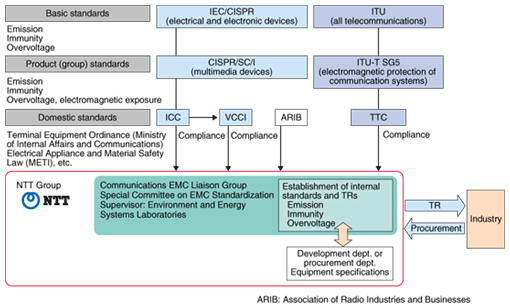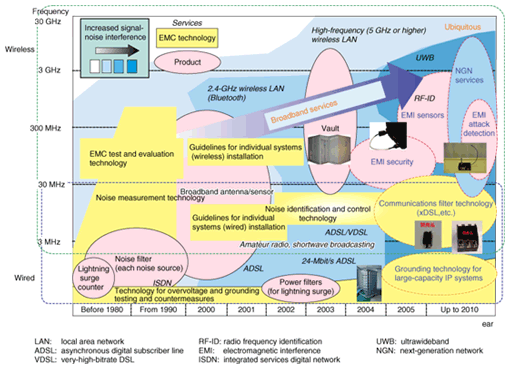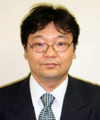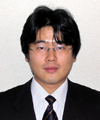 |
|||||||||||||||||||
|
|
|||||||||||||||||||
|
Special Feature: EMC Technology for IP Network Infrastructure Vol. 5, No. 12, pp. 39–44, Dec. 2007. https://doi.org/10.53829/ntr200712sf1 Electromagnetic Compatibility Standards and Their Application in NTT GroupAbstractThis article describes NTT Group specifications concerning electromagnetic compatibility (EMC) technology for supporting the reliability of the telecommunication infrastructure and discusses the circumstances of their application.
1. Importance of EMC technologyVarious broadband services are currently being widely used and the number of Internet subscriptions in Japan is now over 150 million* [1]. The NTT Group is taking up the challenge of constructing a reliable, secure, and convenient telecommunication network on the basis of its medium-term management strategy [2]. That challenge involves both connecting various systems and devices to the telecommunication network and increasing the system capacity and functions. These increases in telecommunication system scale and capacity may also increase the social impact of any failure in the system. At the same time, the electromagnetic environment that surrounds telecommunication systems is getting more and more complex with technological advances, such as progress in high-frequency technology, the use of various electrical and electronic devices, including telecommunication equipment, and the problem of noise that accompanies inverter technology used for greater energy efficiency. Lightning-induced failures are also creating new kind of problems as telecommunication systems change. The issues to be considered in an IP (Internet protocol) network infrastructure are shown in Fig. 1. Various kinds of trouble may occur when there is a change in the environment at a telecommunication center building or a customer”Ēs premises. It is important for electromagnetic compatibility (EMC) technology to advance in step with telecommunication networks if we are to construct secure and reliable networks. We consider EMC to be an important technology for supporting network reliability from the fundamentals of telecommunication. In this article, we explain the approach that the NTT Group is taking to EMC and how EMC is being applied in telecommunication networks.
2. EMC requirements in NTT GroupNTT Group specifications concerning telecommunication EMC are created as internal standards and technical standards, thus simultaneously achieving compliance as a company and improvements in the procurement of equipment, systems, etc. with respect to EMC. Regulation of EMC in NTT began with the establishment of the “Internal Standards for Electromagnetic Disturbance Emitted from Telecommunication Equipment” in 1994. In 1998, the “Internal Standards for Immunity of Telecommunication Equipment” were established. Then, in 2001, those two standards were integrated as the “Internal EMC Standards for Telecommunication Equipment”. Those internal standards were newly revised by including requirements for overvoltage and overcurrent in telecommunication equipment in 2003, as common standards for deciding on telecommunication system procurement specifications. These internal standards are currently being applied in NTT Group. They mainly describe the approach to EMC requirements and application methods for emission, immunity, and overvoltage, etc. The verdict related to “Limits and Measurement Methods for Electromagnetic Disturbances Emitted from Information Technology Equipment” in the Japanese national committee of CISPR (Comité International Spécial des Perturbations Radioélectriques), which is overseen by the Ministry of Internal Affairs and Communication, led to the decision that telecommunication equipment in NTT”Ēs centers should comply with self-set limits on electromagnetic disturbances, while terminal equipment and other such devices provided by NTT should comply with the VCCI (Voluntary Control Council for Interference by Information Technology Equipment) [3] technical requirements. Therefore, the requirements concerning emissions are mandatory regulations, while the requirements for immunity and for overvoltage and overcurrent are currently recommendations. Concerning the actual technical requirements, on the other hand, on the basis of domestic and international EMC regulations, Technical Requirements (TRs) on emission, immunity, and overvoltage have been established and put into practice. The relationships among the internal standards and TRs are shown in Fig. 2.
The emission and immunity TR specifies the technical requirements for telecommunication systems on the basis of the international CISPR Publications 22 and 24, ITU-T (International Telecommunication Union, Telecommunication Standardization Sector) Recommendation K.48, and the findings of JIS (Japanese Industrial Standards) and the verdict of the Telecommunications Council (now the Information and Communications Council (ICC)) in Japan. The overvoltage TR is based on ITU-T Recommendation K.44, etc. The NTT Group participates in VCCI, and devices provided by NTT on the market must be certified in terms of emissions. The telecommunication systems that are installed in telecommunication center buildings are outside the scope of VCCI. They are covered by internal emission management implemented through TRs. 3. ApplicationEMC problems often arise after the introduction of new technology, and even while regulations are being decided, so it is important to understand the situations that occur in the real environment. Therefore, cooperation with NTT Group companies is indispensable. The NTT Environment and Energy Systems Laboratories have organized the “EMC Liaison Group” as a scheme for Group cooperation in sharing information on EMC, with the objective of promoting cooperation among the relevant departments of NTT East, NTT West, NTT Communications, and NTT DoCoMo companies. The organization of the EMC Liaison Group is illustrated in Fig. 3. This group performs activities with the objectives of reporting and sharing information on common EMC problems, focusing on revising and applying the “EMC Internal Standards and Technical Requirements”. By sharing standardization trends and R&D trends related to regulations with the relevant departments, we expect to create more effective and realistic EMC regulations.
At the same time, the “EMC Committee on Internal Standardization” was established to study the direction of the NTT Group as a whole regarding standardization activities and to deliberate on problems in standardization and policies for dealing with them. The standardization promotion organizations are shown in Fig. 4. The telecommunications standardization organization, i.e., ITU-T, is setting standards with respect to problems that are relevant to maintenance and operation in operating companies, such as the problems of electromagnetic induction from power lines and human safety, as well as emission, immunity, and overvoltage [4]. In addition, international standardization activities of the IEC (International Electrotechnical Commission) [5] for creating basic EMC international standards and the CISPR international standards for EMC are progressing. In Japan, VCCI and TTC (Telecommunications Technology Committee) [6] standardization activities are also in progress. For efficient and strategic execution of these domestic and international standardization activities, we expect that the planning and execution of Group cooperation regarding EMC will be increasingly important in the future.
4. Future issues for EMCThrough this mechanism for cooperation within NTT Group, we are currently dealing with the EMC problems foreseen for the next-generation telecommunication infrastructure and telecommunication services. To handle EMC problems in future telecommunication networks, revision of emission requirements is being considered. VCCI plans to revise the following items, corresponding to revisions of CISPR publication 22. (1) Application of the limits for conducted common-mode emission at telecommunication port. (2) Addition of limits and measurement methods for radiated emission over 1 GHz. (3) Obligation to describe measurement uncertainty. In NTT, we will also revise these items with respect to VCCI activities. Moreover, immunity and overvoltage requirements are currently only recommendations, while emission requirements are mandatory. This situation only meets the guidelines published by Japanese industrial associations. However, with the advent of IP technology, realtime services, such as IPTV (Internet protocol television) and VoIP (voice over Internet protocol) are being provided over IP networks, and some leased line services are being shifted from the old telecommunication network to the IP network. These circumstances create new types of EMC problems in the field. Therefore, ensuring the reliability of IP network services is an important issue to be considered. One of the key items to be studied is revisions of immunity and overvoltage test methods, limits, and performance criteria. We consider that immunity and overvoltage requirements should be optimized to suit the circumstances in the field. Therefore, we will optimize these requirements while focusing on standardization activities in TTC [7]. EMC problems experienced up to now and future trends are shown in Fig. 5. The capacity of telecommunication equipment is increasing, and these devices are being used at higher frequencies. We can also assume that problems in the field where EMC has not previously been relevant will continue to increase. These include the issue of grounding that accompanies large-capacity power supplies, which is related to the energy problem, the problem of the safety of high-voltage power supplies, the disclosure of information by the leakage of electromagnetic waves, and defense against electromagnetic attacks by malicious third parties. We will also consider security-related problems such as electromagnetic sensing that applies EMC technology. Concerning these new EMC problems, we plan to make use of schemes for Group cooperation like the EMC Liaison Group. Collaboration among NTT and the other operating companies is important to enable research and development activities to proceed. Moreover, standardization activities, such as revising EMC standards and attending international standardization bodies, are also important to ensure reliable telecommunication networks.
5. Future developmentWith the progress in electronics technologies, new EMC problems are arising from various causes in the field. Since the reorganization of NTT R&D in 1987, NTT has consistently been performing telecommunication EMC R&D and pursuing standardization related to it. To obtain technology that provides fundamental support for achieving a secure and reliable telecommunication network, we will continue with R&D to solve EMC problems. We will also continue to reflect our results in standardization activities in Japan and abroad, aiming for a network that is free of EMC failures through EMC regulation that is both more realistic and the minimum necessary. References
|
|||||||||||||||||||








